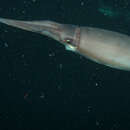Diagnostic Description
provided by FAO species catalogs
A very large squid. Mantle very large, robust, thick-walled. Fins rhomboidal, muscular, broad, width 56% of mantle length (49 to 65%), length 45% (41 to 49%) of mantle length, single fin angle 570 (50 to 65%). Distal end of arms (adults especially) drawn out into very long, attenuate tips with 100 to 200 minute, closely packed suckers; dorsal protective membrane very weakly developed, but trabeculae are well-developed, exposed papillae, either arm IV hectocotylized (not both on same specimen) by absence of suckers and stalks at tip, and expanded and perforated protective membranes.
- Ehrhardt et al. (in press, biology and fishery, Gulf of California, Mexico)
- Sato, (1976, exploratory fishing, Mexico).
- bibliographic citation
- FAO Species catalogue VOL. 3. Cephalopods of the world An Annotated and Illustrated Catalogue of Species of Interest to FisheriesClyde F.E. Roper Michael J. Sweeney Cornelia E. Nauen 1984. FAO Fisheries Synopsis No. 125, Volume 3
- author
- Food and Agriculture Organization of the UN
Distribution
provided by FAO species catalogs
Eastern Pacific: from approximately 35° N south to Tierra del Fuego.
- bibliographic citation
- FAO Species catalogue VOL. 3. Cephalopods of the world An Annotated and Illustrated Catalogue of Species of Interest to FisheriesClyde F.E. Roper Michael J. Sweeney Cornelia E. Nauen 1984. FAO Fisheries Synopsis No. 125, Volume 3
- author
- Food and Agriculture Organization of the UN
Size
provided by FAO species catalogs
Maximum total length 4 m, maximum mantle length 1.5 m off Chile, about 1 m in the northern population; length at first maturity in the latter ranges between 35 and 40 cm in females (4 to 6 months of age) and from 18 to 25 cm in males (2 to 3 months of age). Common length about 50 to 80 cm, common weight 2 or 3 kg.
- bibliographic citation
- FAO Species catalogue VOL. 3. Cephalopods of the world An Annotated and Illustrated Catalogue of Species of Interest to FisheriesClyde F.E. Roper Michael J. Sweeney Cornelia E. Nauen 1984. FAO Fisheries Synopsis No. 125, Volume 3
- author
- Food and Agriculture Organization of the UN
Brief Summary
provided by FAO species catalogs
An oceanic and neritic speciesoccurring from the surface to 500 m depth;it is most abundant and largest off South America,where adults are found in water temperatures of between 26 and 28°C to much colder. In nearshore waters, it occurs near to the surface day and night. In the Gulf of California a single stock composed of several cohorts has been identified.Its seasonal migrations, similar to those of other ommastrephids, are described by Ehrhardt et al. (in press).The cohorts grow at different rates depending on the environmental conditions at the time of hatching, but all recruit into the fishery around May each year. Longevity is about 1 year for the population in the northern hemisphere. Mortality after spawning is high.This species feeds on larvae of pelagic fishes such as lanternfishes, sardines, mackerels and sauries, and on crustaceans. Cannibalism is common.It is in turn preyed upon by swordfish, sharks, porpoises and other mammals.
- bibliographic citation
- FAO Species catalogue VOL. 3. Cephalopods of the world An Annotated and Illustrated Catalogue of Species of Interest to FisheriesClyde F.E. Roper Michael J. Sweeney Cornelia E. Nauen 1984. FAO Fisheries Synopsis No. 125, Volume 3
- author
- Food and Agriculture Organization of the UN
Benefits
provided by FAO species catalogs
Exploratory fishing for this species was initiated in the early seventies in several areas along the Pacific coast of America. While the operations by Japanese vessels off Chile were discontinued because of insufficient landings, Mexican catches increased from 14 t in 1974 to over 19 000 t in 1980, but deteriorated subsequently, to about 10 000 t in 1981 (FAO, 1983) and to even lower levels in the 1982-83 fishing season. Most of these catches are taken by Japanese jigger boats under a joint venture scheme and by Mexican shrimpers that switch to squid fishing during the closed season for shrimp fishing. The best catches are obtained during the summer months, but the season has been progressively expanded, so that fishing now occurs throughout the year. Jigging operations are enhanced at night by light attraction. The sport fishery for the species, off southern California, is of very limited importance. This squid is mainly used as bait, some of it is dried for human consumption, and in Chile, small amounts are marketed canned. A market for frozen filets has recently developed in the western USA. The total catch reported for this species to FAO for 1999 was 134 773 t. The countries with the largest catches were Mexico (57 985 t) and Peru (54 652 t).
- bibliographic citation
- FAO Species catalogue VOL. 3. Cephalopods of the world An Annotated and Illustrated Catalogue of Species of Interest to FisheriesClyde F.E. Roper Michael J. Sweeney Cornelia E. Nauen 1984. FAO Fisheries Synopsis No. 125, Volume 3
- author
- Food and Agriculture Organization of the UN

